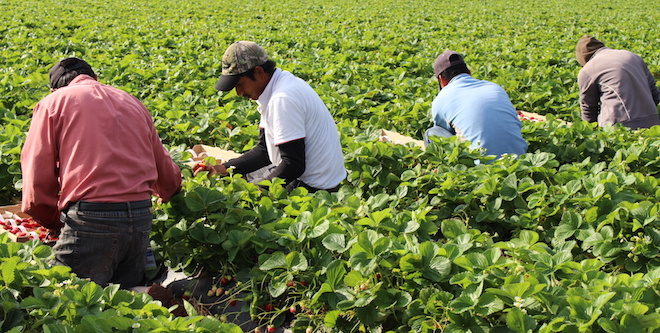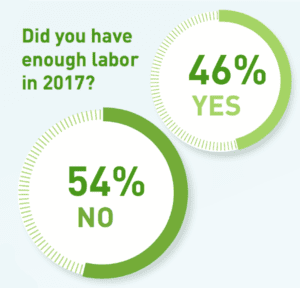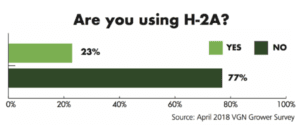

May 18, 2018VGN survey results show farm staffing struggles
For the second consecutive year, the majority of growers who responded to a labor survey conducted by Vegetable Growers News reported they experienced severe worker shortages in 2017. Most continue to search for labor solutions to meet their crop production goals.
The survey – conducted in the first quarter of 2018 – asked growers if they had enough labor in 2017. More than 53 percent indicated they did not have adequate worker numbers for the previous season. That percentage matched the 2017 survey results that inquired about 2016 worker totals.
Just 46 percent of farm operators had enough labor in 2017, compared to 47 percent for 2016.


“In the past four to five years, this farm has lost in excess of $200,000-$250,000 of unharvested or poor-quality produce that spoiled in storage because of the lack of reliable workers available to harvest in a timely fashion,” one farm said of its labor situation.
Respondents who were asked what percentage of workers they lacked from their required worker numbers, showed a range of 10-75 percent in shortfalls from the labor needed to accomplish required tasks.
And of the workers who did come, there were concerns from growers about their productivity.
“We received workers we needed, but they were much slower than previous crews,” one respondent said.
Such conditions led to working longer hours and using workers that were not normally trained for harvest duties in the fields.
One found a familiar but challenging solution: “We hire youth labor for our small farm – 15 acres of vegetable production.”
Unharvested crops
The majority of the farms responding indicated that short staffing led to leaving crops in the field. Harvest timing for some was impacted, in one case leading to storage losses.
The percentage of crops that went unharvested ranged from five percent to 35 percent in one case.
Attempts to make up for a lack of worker availability were frustrating for the responding growers, leading operators and current personnel to work longer hours, charge slightly higher prices, and in one case exit the profession out of a sense of futility.
“We prayed hard and then exited a 38-year lifetime vocation,” indicated one frustrated owner.
Some of the work did not get done in a timely manner, causing reduced plantings and yield reductions, the respondents indicated.
“What do you want me to do?” one grower asked.
Comments provided by respondents reflected a number of different approaches, but most echoed similar themes.
“We are located in an area that is very seasonal and has a large fishing and tourism industry. (It’s) very hard to be competitive in wages,” one grower responded.


H-2A concerns
The cumbersome H-2A visa program is growing annually, but it is catching on slowly with those operations that responded to the VGN questionnaire. Just 33 percent used the program in 2017, with 77 percent not pursuing that option.
While some operations just don’t see H-2A as being a good fit for them – some due to the size of the farm – a number of specific concerns were raised by those not using the program, including the following:
“I’m not sure. I don’t really understand the process.”
“We can’t afford it, and don’t have the facilities.”
“It’s too costly and burdensome for the size of our operation and level of production.”
“I prefer local workers.”
“I just started hearing about H-2A. I am not familiar with how it works. I don’t know how to go about utilizing the program. I need full-time seasonal workers. Does H-2A address that need?”
“It’s too complicated. Too many rules. If I have to use it, it may be a good time to retire, or cut back on hand-harvested crops.”
“The rules and regulations are crazy.”
“H-2A was designed to discourage employers from hiring foreign workers and ‘protect’ American jobs.”
“(It’s) expensive. One guy is always delayed for no good reason; (we) like that we have our same guys year after year.”
“It seems a lot of workers are just coming for an easy check now. It’s harder and harder to find good workers for a short season.”
“The crops don’t always follow the contract cycle, so you have to have them hired sooner than needed.”
“The majority of the crew we had last year just wanted to work by the hour. We did not have enough people make piece-work rate. In past years, all workers could make rate after two weeks.”
“Inspections, housing, transportation – a lot of extra rules.”
“All the paperwork and hassle … if it was easier, we would use the program.”
Some believe H-2A may be something they move toward.
“I have not done the research needed but intend to in the future,” one grower said.
“H-2A is a complicated program that used to be worth the hassle, but it seems too many good workers are choosing to go to places that the season is longer. If your season is short, you get poorer workers and more heavy drinkers.”
Some positive aspects of the H-2A program were identified, but most of the kudos were couched with concerns.
“It’s a secure workforce, but very expensive and regulated,” one operator said.
“(They are) good, quality workers that do the job right. It’s a pain in the butt with all the paperwork.”
“I believe in this program and it can be successful and make farmers successful as well. But the federal government does not make it easy for us and it’s expensive to use.”
Many of the respondents assailed the political dynamics for magnifying the current ag labor woes.
“The government needs to stop vilifying immigrants,” one grower wrote. “Without them, this country will cease to grow – literally!”
“It’s time for the Congress to quit playing politics and solve the problem they started in 1986 law but never completed as designed!”
“The federal government needs to implement a temp ag worker card.”
— Gary Pullano, managing editor














